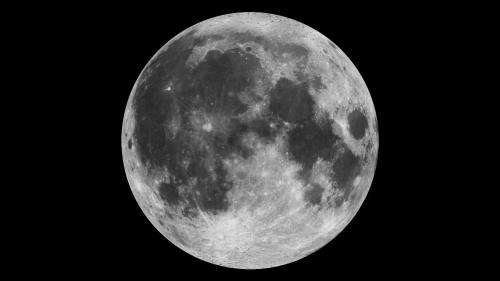From today, the Earth is around 60 million years older—and so is the Moon

Work presented today at the Goldschmidt Geochemistry Conference in Sacramento, California shows that the timing of the giant impact between Earth's ancestor and a planet-sized body occurred around 40 million years after the start of solar system formation. This means that the final stage of Earth's formation is around 60 million years older than previously thought.
Geochemists from the University of Lorraine in Nancy, France have discovered an isotopic signal which indicates that previous age estimates for both the Earth and the Moon are underestimates. Looking back into "deep time" it becomes more difficult to put a date on early Earth events. In part this is because there is little "classical geology" dating from the time of the formation of the Earth – no rock layers, etc. So geochemists have had to rely on other methods to estimate early Earth events. One of the standard methods is measuring the changes in the proportions of different gases (isotopes) which survive from the early Earth.
Guillaume Avice and Bernard Marty analysed xenon gas found in South African and Australian quartz, which had been dated to 3.4 and 2.7 billion years respectively. The gas sealed in this quartz is preserved as in a "time capsule", allowing Avice and Marty to compare the current isotopic ratios of xenon, with those which existed billions of years ago. Recalibrating dating techniques using the ancient gas allowed them to refine the estimate of when the earth began to form. This allows them to calculate that the Moon-forming impact is around 60 million years (+/- 20 m. y.) older than had been thought.
Previously, the time of formation of the Earth' s atmosphere had been estimated at around 100 million years after the solar system formation. As the atmosphere would not have survived the Moon-forming impact, this revision puts the age up to 40 million years after the solar sytem formation (so around 60 million years older than previously thought).
According to Guillaume Avice: "It is not possible to give an exact date for the formation of the Earth*. What this work does is to show that the Earth is older than we thought, by around 60 my.
"The composition of the gases we are looking at changes according the conditions they are found in, which of course depend on the major events in Earth's history. The gas sealed in these quartz samples has been handed down to us in a sort of "time capsule". We are using standard methods to compute the age of the Earth, but having access to these ancient samples gives us new data, and allows us to refine the measurement".
The xenon gas signals allow us to calculate when the atmosphere was being formed, which was probably at the time the Earth collided with a planet-sized body, leading to the formation of the Moon. Our results mean that both the Earth and the Moon are older than we had thought".
Bernard Marty added: "This might seem a small difference, but it is important. These differences set time boundaries on how the planets evolved, especially through the major collisions in deep time which shaped the solar system".
More information: *The oldest rocks of the solar system have been dated to 4,568 my ago, so the Earth is younger than that.
The Goldschmidt Conference is the world's leading annual conference on geochemistry. It takes place in Sacramento, California from 8-13 June 2014. goldschmidt.info/2014/.
Presentation: The age of the Earth-Moon system revisited using xenon isotope systematics:
Abstract
Recently, xenon trapped in fluid inclusions of Archean samples from North Pole, Pilbara (Australia) was found to be isotopically intermediate between cosmochemical endmembers (chondritic or solar) and the atmosphere [1, 2]. These results have been interpreted as resulting from prolonged loss of Xe atoms from the atmosphere to the outer space, that lasted at least until the end of the Archean eon [3]. Archean samples analysis together with modeling could help to put further constraints on the early history of the Earth-Moon system. We have analyzed noble gases (Xe, Kr and Ar) in fluid inclusions contained in quartz veins from the Barberton greenstone belt (South Africa) in order to (i) check if this noble gas fractionation represents, or not, a worldwide signature of the Archean atmosphere, (ii) get a more precise isotope analysis of Archean noble gases, and (iii) investigate the Xe isotopic evolution through geological periods of time. The Archean (≈3.2 Ga) Xe isotope ratios, analyzed with a permil precision, indicate an isotopic fractionation of 1.0 ± 0.1 %.amu-1 in favor of the lighter isotopes for the Archean atmosphere relative to the modern one. These results confirm the fractionated state of the archean atmospheric xenon, as a result of prolongated Xe escape from the atmosphere through time. A model has been built to reproduce the temporal evolution of the isotopic composition of atmospheric xenon after a major impact and to take into account the addition of radiogenic/fissiognic Xe atoms from extinct radioactivities (129I, 244Pu and 238U). It permits to put constraints on the I-Pu- Xe age of the Earth-Moon system. The model reproduces with <1% the Xe isotopic compositions of the Archean and the modern atmospheres. It also resolves the unexplained atmospheric under-abundance of Xe isotopes from the fission of 244Pu. When corrected for prolonged loss, I-Pu-Xe ages of the Earth-Moon system are reconciled and shift from 70-100 Ma as previously thought, to 40±20 Ma after CAI.
Provided by European Association of Geochemistry



















